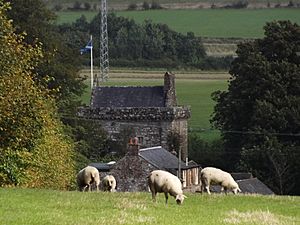Bonshaw Tower facts for kids
Bonshaw Tower is a cool old tower house in Scotland. It's near Kirtlebridge, above the Kirtle Water. This tower was probably built in the mid-1500s. It was one of many strong buildings made along the Scottish border. These towers helped protect people from attacks by the English. Right next to it is a bigger house built in the 1800s.
History of Bonshaw Tower
Bonshaw Tower has a long and interesting past. It was the home of the Irving family for hundreds of years. The Irvings of Bonshaw owned it without a break until 1954.
Records show the tower was built around 1570. It was even burned and blown up by the English in the same century! But don't worry, it was rebuilt later. There were several battles around the tower during those times.
The house attached to the tower was first built around 1770. It got much bigger starting in the 1840s. Even a king visited Bonshaw! King James VI came to the tower in 1601 or 1602. Back then, it was called "Boneschaw."
There are stories of an even older Bonshaw Tower from 1298. It's said that Robert the Bruce found safety there. The owner at that time was Sir William de Irving.
Today, Bonshaw Tower is still owned by members of the Irving family. It's their family home. Sometimes, the tower or its gardens can be used for special events like weddings.
What Bonshaw Tower Looks Like
Bonshaw Tower is a strong building that people can still live in. It has three main floors and an attic at the very top. The roof edges have a special shape called crow-stepped gables.
When you go inside, there's a modern entrance. Above the door, you can see a special message: "SOLI DEO HONOR ET GLORIA." This means "To God alone be honour and glory."
Inside, a cool arched passage leads to a basement. This basement has very thick walls. There's even a small, dark room in one corner, like a tiny dungeon. A secret hatch in the basement ceiling leads up to the first floor. From the basement, a spiral staircase goes up to all the floors of the tower.
The main hall on the first floor has a big fireplace. It also has four windows. There are small storage spaces, called aumbries, built into the walls.
On the second floor, there's a bedroom. It has a closet built into the wall and a special old toilet, called a garderobe. One of its four windows is placed high up on the wall.
The top of the tower has special openings called machicolations. These were used to drop things on attackers below. The roof you see today was put on in the early 1800s. The original roof was made of flat stones, but they were taken off to be used for a farmhouse floor!


